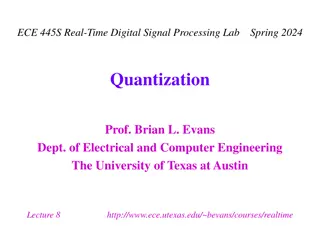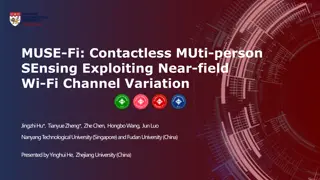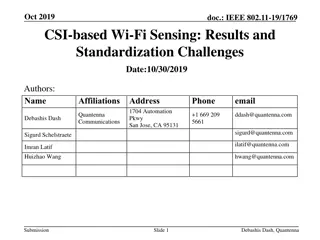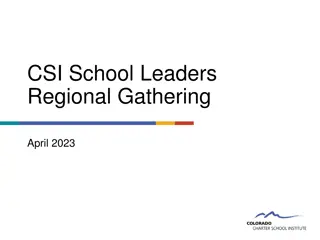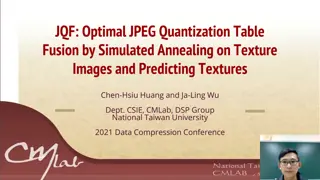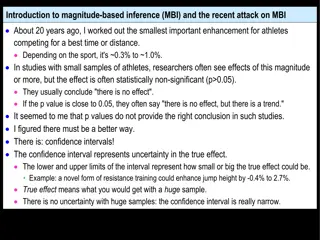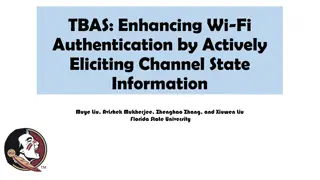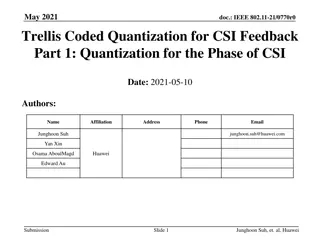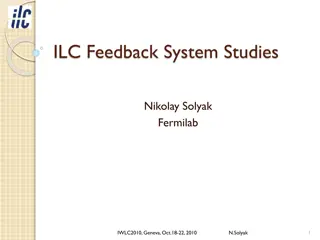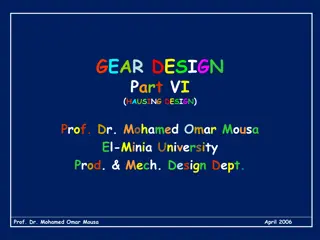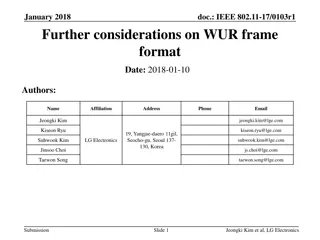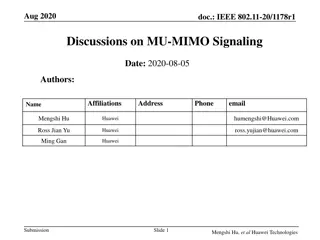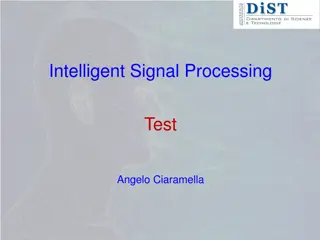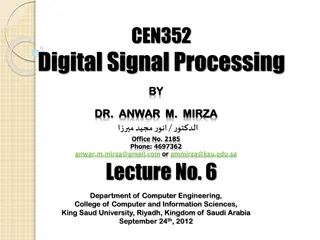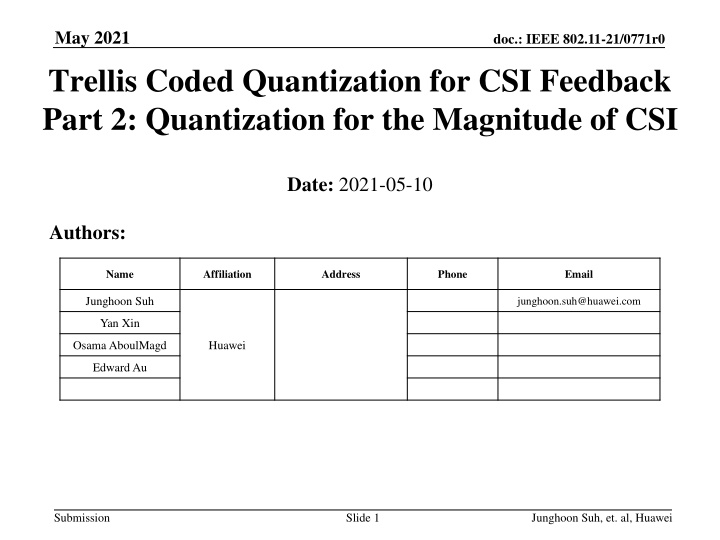
Trellis Coded Quantization for CSI Feedback Part 2: Magnitude Quantization
In this document, the authors delve into applying Trellis Coded Quantization (TCQ) to the magnitude of Channel State Information (CSI) feedback. They discuss converting Rayleigh-distributed samples to uniformly distributed samples for quantizing the CSI magnitude. The content covers statistics of Rayleigh distribution, generation of random variables, and histograms per OFDM symbol of measured CFR. The process involves averaging over OFDM symbols, determining scaling factors, and converting magnitudes to uniformly-distributed samples. The aim is to enhance understanding of quantization techniques in the context of CSI feedback for sub-7 GHz applications.
Download Presentation

Please find below an Image/Link to download the presentation.
The content on the website is provided AS IS for your information and personal use only. It may not be sold, licensed, or shared on other websites without obtaining consent from the author. If you encounter any issues during the download, it is possible that the publisher has removed the file from their server.
You are allowed to download the files provided on this website for personal or commercial use, subject to the condition that they are used lawfully. All files are the property of their respective owners.
The content on the website is provided AS IS for your information and personal use only. It may not be sold, licensed, or shared on other websites without obtaining consent from the author.
E N D
Presentation Transcript
May 2021 Trellis Coded Quantization for CSI Feedback Part 2: Quantization for the Magnitude of CSI doc.: IEEE 802.11-21/0771r0 Date: 2021-05-10 Authors: Name Affiliation Address Phone Email Junghoon Suh junghoon.suh@huawei.com Yan Xin Osama AboulMagd Huawei Edward Au Submission Slide 1 Junghoon Suh, et. al, Huawei
May 2021 doc.: IEEE 802.11-21/0771r0 Background This PPT slides continue to describe the application of TCQ to the CSI Feedback In the Part 1, we described on how to apply the TCQ for the phase of the measured CSI We propose how to convert the Rayleigh distributed samples into a uniform distributed samples and apply the TCQ for the quantization of the CSI Magnitude in this Part 2 CSI matrix should be considered as a sensing measurement result type for sub-7 GHz applications [1] CSI matrix Real and imaginary parts of each element of the matrix (that is, sub-carrier for each antenna/antenna pair). Report would be the estimated CFR no loss of information as in the compressed beamforming feedback matrix. Submission Slide 2 Junghoon Suh, et. al, Huawei
May 2021 doc.: IEEE 802.11-21/0771r0 Statistics of Rayleigh Distribution When the measured CSI (CFR) are represented in the magnitudes and phases, the magnitudes are approximately Rayleigh-distributed PDF of Rayleigh-Distributed Random Variable (x) is ? ?,? =? and ? is a scaling factor ?2? ?2/ 2?2, where x is greater than or equal to 0 ? 2 Mean of x is, ? ? = ? The generation of Rayleigh-Distributed samples is given from the following equation, ? = ? ?ln?, where U is Uniformly-Distributed between 0 and 1. Hence, we can have the following relation, ? = ? ?2/ 2?2to convert the Rayleigh samples into the Uniform samples with the range between 0 and 1 Submission Slide 3 Junghoon Suh, et. al, Huawei
May 2021 doc.: IEEE 802.11-21/0771r0 Histogram per OFDM Symbol of Measured CFR (Magnitude) : 4 PPDUs are plotted below, but similar trend for all the tested PPDUs with IEEE Chan D Submission Slide 4 Junghoon Suh, et. al, Huawei
May 2021 Quantization for the Magnitudes of CSI First of all, we take the average over an OFDM symbol for the magnitude samples from each measured CSI per sub-carrier doc.: IEEE 802.11-21/0771r0 Second, we can obtain the scaling factor (?) from the following equation, ? ? ?/? where ? ? is the average obtained at the First step If the scaling factor is greater than 16, the channel normalization should be taking place before converting the CFR into the magnitude and phase Third, we convert the magnitude samples of an OFDM symbol to the uniformly-distributed samples ranged between 0 and 1 according to the following equation, ? = ? ?2/ 2?2 where x is the magnitude samples, ? is the scaling factor obtained at the Second step and U is the converted samples Once we obtain the uniformly-distributed samples U , we can now apply the TCQ to the U ranged between 0 and 1. We feedback the TCQ outputs and ? to the Initiator The Initiator, first of all, recovers the U samples from the fed-back TCQ outputs and convert them to the magnitude samples x with the following equation, ? = ? ?ln? Submission Slide 5 Junghoon Suh, et. al, Huawei
May 2021 doc.: IEEE 802.11-21/0771r0 TCQ for uniform-distributed samples U ranged between 0 and 1 We use the 802.11 BCC Trellis Scheme = + 2 ( * )% 64 S S u Forward State Transition Function: 1 i i i We use the same Codeword generation method as in Part 1, but just the lower and upper bounds of the source data are changed to 0 and 1 Submission Slide 6 Junghoon Suh, et. al, Huawei
May 2021 doc.: IEEE 802.11-21/0771r0 Codeword Generation For an n-bit TCQ quantizer, the codebook is divided into four sub-codebooks, each with N/2 codewords, where N = 2n. When the i-th (0<= i <= 3) sub-codebook is denoted as ??= ? ? ?, where ??,? is the l-th codeword in Ci . These sub-codebooks are generated in the following way. Let Lb and Ub be the lower and upper bounds of source data. Let =?? ?? ??,??=? ?/2 and ? = 4=?? ?? 2? , then ??,?=??+ ? + ? + 0.5 ?. Depending on the trellis scheme, Ci can be arranged to make the distance between Ci s maximallyequal, when mapped to the trellis output bits. Submission Slide 7 Junghoon Suh, et. al, Huawei
May 2021 doc.: IEEE 802.11-21/0771r0 For an example with 8 bit TCQ, N=28=256 and the source data samples to be quantized being uniformly distributed between 0 ??? ? There are 4 sub-codebooks and 128 codewords in each sub-codebook, thus, C0 to C3 are obtained as follows according to the method in slide 6 ??= { .?????????,.?????????, ., ??= { .?????????,.?????????, .., ??= {.?????????,.?????????, ..., .?????????,.?????????} ??= {.?????????,.?????????, .. ., The Lb and Ubin the previous slide corresponds to ? ??? ? , respectively .?????????, .993164063 .993164063} .?????????,.?????????} .?????????,.?????????} Submission Slide 8 Junghoon Suh, et. al, Huawei
May 2021 doc.: IEEE 802.11-21/0771r0 1/01 The subscript i in Ci representsthe output bits in a state transition, and the 00 is paired with 11 and 01 is paired with 10 in the outgoing branches from a state as we see from the figure beside In order to make the distances among sub-codebooks maximally equal, ?? ??? ??correspond to the output bit 00, ??correspond to 01, ??correspond to 11, and ??correspond to 10 63 63 0/10 62 62 1/00 61 0/11 60 .. .. . 15 14 1/01 13 0/10 12 1/00 11 0/11 10 1/10 9 0/01 8 1/11 7 7 0/00 6 6 1/01 5 5 Therefore, each outgoing branch from a state has a corresponding output and thus has a corresponding sub-codebook 0/10 4 4 1/00 0/11 3 3 1/10 2 2 0/01 1/11 1 1 0/00 0 0 Submission Slide 9 Junghoon Suh, et. al, Huawei
May 2021 doc.: IEEE 802.11-21/0771r0 Quantization of scaling factor ( ? ) The range of scaling factor can be any number beyond 0, usually ranged between 1 and 16 This scaling factor is quantized once per sensing frame, and without being fed-back per each sub-carrier The scaling factor can be any real number greater than 0, so we propose to quantize the Decimal number and the fractional value below decimal point separately. We assign M bits for the decimal number, and assign K bits for the value below the decimal points E.g. M is 4 bits, and K is 12 bits. Then, M bits represent the decimal points from 1 to 16, and K bits provide 212 ,4096 quantization steps between 0 and 1 For the scaling factor 4.7125762 as an e.g., the decimal number is 0100, and the fractional value below decimal point is quantized by choosing an 12 digit index closest to .7125762 Submission Slide 10 Junghoon Suh, et. al, Huawei
May 2021 doc.: IEEE 802.11-21/0771r0 Simulation We used the same convolutional scheme as in 802.11 (Slide 5) We generated the Chan D to measure the CSI information Magnitude information is computed per each subcarrier Rayleigh Distribution Convert it into Uniform Distribution 8 bit TCQ n = 8 and N=28=256, 9 bit TCQ n = 9 and N=29=512 Source to Quantization Noise Ratio (SQNR) : 10log(E(x2)/E(q2)) (dB), where x is the source data and q is the quantization noise TCQ shows 1 dB gain compared to the Scalar Quantization (SQ) MSE (E(q2)) 2.236e-4 2.894e-4 5.587e-5 7.775e-5 SQNR (dB) 53.5077 52.3948 59.529 58.1106 TCQ (8bit) SQ (8bit Scalar Quantization) TCQ (9bit) SQ (9bit Scalar Quantization) Submission Slide 11 Junghoon Suh, et. al, Huawei
May 2021 doc.: IEEE 802.11-21/0771r0 Summary We proposed to use the TCQ scheme to quantize the magnitudes of the measured CSI It is provided how to convert the Rayleigh-distributed samples into the Uniformly-distributed samples This result shows 1 dB better SQNR gain than using the Scalar Quantization Submission Slide 12 Junghoon Suh, et. al, Huawei
May 2021 doc.: IEEE 802.11-21/0771r0 SP1 Do you support to convert the CSI (CFR) in complex number to the CSI (CFR) in phase & magnitude for the Quantization of CSI ? Submission Slide 13 Junghoon Suh, et. al, Huawei
May 2021 doc.: IEEE 802.11-21/0771r0 SP2 Do you support to convert the Rayleigh Samples of CSI Magnitudes to the Uniform Distributed Samples before applying a Quantization as described in slide 5? Submission Slide 14 Junghoon Suh, et. al, Huawei
May 2021 doc.: IEEE 802.11-21/0771r0 SP3 Do you support the TCQ for the Quantization of CSI ? Codeword generation of Sub-Codebooks is described in Slide 6 of 21/770r0 FB informations of the TCQ are Beginning State, input bits, and Codewords index of the corresponding Sub-codebook Submission Slide 15 Junghoon Suh, et. al, Huawei
May 2021 doc.: IEEE 802.11-21/0771r0 SP4 Do you support the Quantization of Scaling Factor as described in slide 10? Submission Slide 16 Junghoon Suh, et. al, Huawei
May 2021 doc.: IEEE 802.11-21/0771r0 Reference [1] C. da Silva, et. al., Discussion of Sensing Measurement Result Types , 802.11-21/0357r1, Mar. 2021 [2] J. Zhang, et. al., Trellis-Coded Quantization of Phases in MISO Wireless Systems , TELKOMNIKA, Vol.10, No.7, November 2012, pp. 1808~1814 [3] M. Marcellin, et. al., Trellis Coded Quantization of Memoryless and Gauss-Markov Sources , IEEE TRANSACTIONS ON COMMUNICATIONS, VOL. 38, NO. 1, JANUARY 1990 Submission Slide 17 Junghoon Suh, et. al, Huawei

